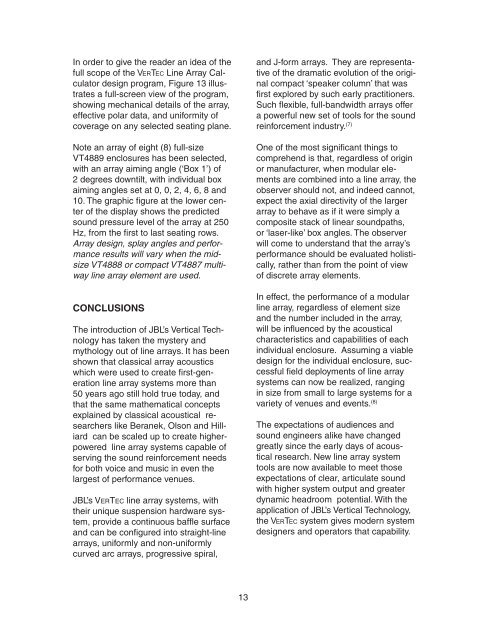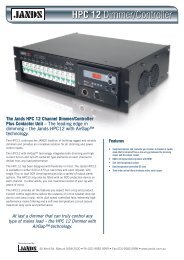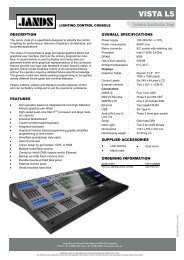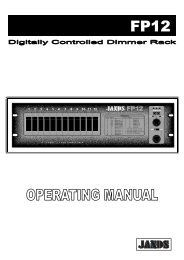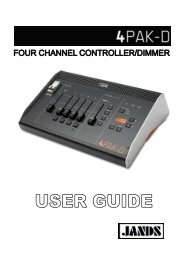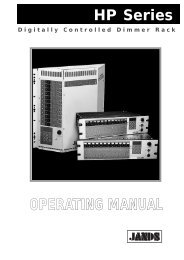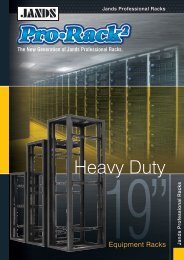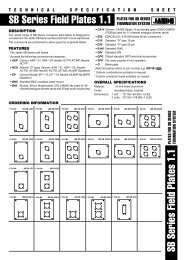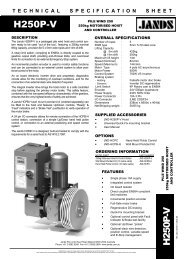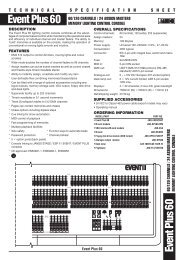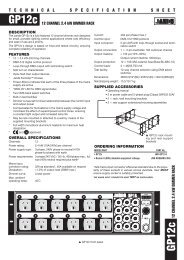VERTEC White Paper.indd - Jands
VERTEC White Paper.indd - Jands
VERTEC White Paper.indd - Jands
Create successful ePaper yourself
Turn your PDF publications into a flip-book with our unique Google optimized e-Paper software.
In order to give the reader an idea of thefull scope of the <strong>VERTEC</strong> Line Array Calculatordesign program, Figure 13 illustratesa full-screen view of the program,showing mechanical details of the array,effective polar data, and uniformity ofcoverage on any selected seating plane.Note an array of eight (8) full-sizeVT4889 enclosures has been selected,with an array aiming angle (‘Box 1’) of2 degrees downtilt, with individual boxaiming angles set at 0, 0, 2, 4, 6, 8 and10. The graphic figure at the lower centerof the display shows the predictedsound pressure level of the array at 250Hz, from the first to last seating rows.Array design, splay angles and performanceresults will vary when the midsizeVT4888 or compact VT4887 multiwayline array element are used.CONCLUSIONSThe introduction of JBL’s Vertical Technologyhas taken the mystery andmythology out of line arrays. It has beenshown that classical array acousticswhich were used to create first-generationline array systems more than50 years ago still hold true today, andthat the same mathematical conceptsexplained by classical acoustical researcherslike Beranek, Olson and Hilliardcan be scaled up to create higherpoweredline array systems capable ofserving the sound reinforcement needsfor both voice and music in even thelargest of performance venues.JBL’s <strong>VERTEC</strong> line array systems, withtheir unique suspension hardware system,provide a continuous baffle surfaceand can be configured into straight-linearrays, uniformly and non-uniformlycurved arc arrays, progressive spiral,and J-form arrays. They are representativeof the dramatic evolution of the originalcompact ‘speaker column’ that wasfirst explored by such early practitioners.Such flexible, full-bandwidth arrays offera powerful new set of tools for the soundreinforcement industry. (7)One of the most significant things tocomprehend is that, regardless of originor manufacturer, when modular elementsare combined into a line array, theobserver should not, and indeed cannot,expect the axial directivity of the largerarray to behave as if it were simply acomposite stack of linear soundpaths,or ‘laser-like’ box angles. The observerwill come to understand that the array’sperformance should be evaluated holistically,rather than from the point of viewof discrete array elements.In effect, the performance of a modularline array, regardless of element sizeand the number included in the array,will be influenced by the acousticalcharacteristics and capabilities of eachindividual enclosure. Assuming a viabledesign for the individual enclosure, successfulfield deployments of line arraysystems can now be realized, rangingin size from small to large systems for avariety of venues and events. (8)The expectations of audiences andsound engineers alike have changedgreatly since the early days of acousticalresearch. New line array systemtools are now available to meet thoseexpectations of clear, articulate soundwith higher system output and greaterdynamic headroom potential. With theapplication of JBL’s Vertical Technology,the <strong>VERTEC</strong> system gives modern systemdesigners and operators that capability.13


